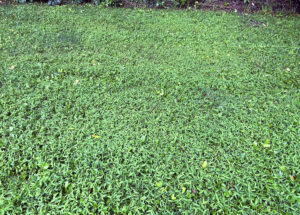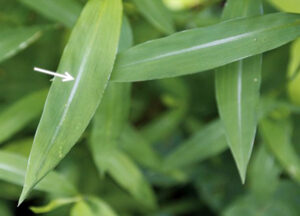
A mat of Japanese stiltgrass in Rock County, Wisconsin, in July 2025. / Photo Credit: John Zaborsky, University of Wisconsin-Madison Renz Weed Science Lab
By Wisconsin DNR
Thanks to the help of eagle-eyed observers across southern Wisconsin, the harmful invasive plant Japanese stiltgrass (Microstegium vimineum) has now been detected in three additional counties. That brings the total number of Wisconsin counties to five.
The most recent detections of the non-native, annual grass came in Dane, Grant and Walworth counties. The Dane County find was in Middleton, northwest of Madison; in Grant County, it was found southeast of Wyalusing State Park; in Walworth County, it was found north of Geneva Lake.
Earlier in the summer, a detection was made in Rock County, near Beloit.

A close-up photo of Japanese stiltgrass leaves, showing their characteristic off-center silver midrib markings (white arrow). / Photo Credit: John Zaborsky, University of Wisconsin-Madison Renz Weed Science Lab
The first detection was made in 2020, inside the Coulee Experimental Forest in La Crosse County. The Wisconsin Department of Natural Resources (DNR) has been working to eradicate that population and is working with property owners to control and/or eradicate the other infestations.
Japanese stiltgrass poses a significant threat to Wisconsin’s ecosystems. It grows in branching, sprawling mats in forests, streams, trails, ditches and lawns. In the eastern and southern United States, including Illinois, it is widespread and has been negatively impacting forests.
Even though a survey surrounding the site of the Rock County discovery uncovered no additional infestationsUW-Madison Extension issued a call to action, asking for help from southern Wisconsin residents.
That action helped to uncover the additional infestations. Now, Extension and the DNR ask residents in southern Wisconsin counties — particularly Grant, Green, Kenosha, Lafayette, Rock and Walworth — to continue searching nearby neighborhoods and woodlands for Japanese stiltgrass.
If you believe to have found this invasive plant, it should be immediately reported to one or both of the following email addresses:
- UW-Madison Extension’s Forestry team: Forestry@extension.wisc.edu
- The DNR Invasive Species team: Invasive.Species@wisconsin.gov
Reports should include:
- Close-up photos of the grass, along with mid-range and wide-angle photos that show the landscape.
- The exact location of the infestation, along with the plants’ size, habitat and density.
A UW-Madison Extension blog post contains extensive facts on Japanese stiltgrass, tips on accurate identification (including an instructional video and multiple photos) and possible actions to take if the plant is verified in a new location.
“This plant is quite harmful to our forests,” said Mark Renz, a professor and UW-Madison Extension weed specialist. “It makes wildfires more frequent and severe, alters nutrient cycling and soil microbes and reduces wildlife habitat, all of which decreases biodiversity.”
